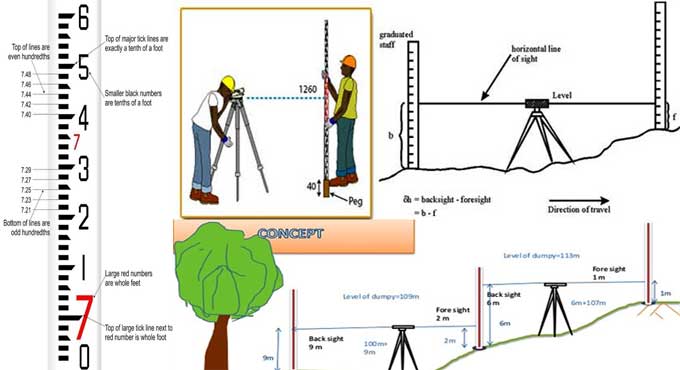
The Principles and Methods of Labeling in Survey Engineering
Leveling is a sub-division of surveying. A level is an instrument used to measure the proportional height of different points on the earth's surface. That happens for the following reasons:
- Finding the elevations of specified points to an ideal datum or a certain datum.
- To settle points at a given or anticipated datum.
It helps with the design of a work, whereas it is essential to organize engineering works of any kind. Vertical measurements are best by leveling.
Level Surface
It is a curved surface that bases on its gravity and is parallel to its gravitational direction at every point. Water, for instance, is a level surface. Typically, a level surface is analogous to the spherical base of the earth.
Level Line
A tangential line locates at a specific point on a level surface. Therefore, plumb lines are normal at every location.
Horizontal Plane
A horizontal plane via a point refers to a plane perpendicular to that point's level surface. By way of the point, it's perpendicular to the plumb line.
Horizontal Line
It is a straight line at a point that runs parallel to the level line. The plumb line and this line are also orthogonal.
Vertical Line
The level line is parallel to this line at a point. As described by a plumb line, it is generally taken as a straight line.
Vertical Angle
An angle in a vertical plane represents the intersection of two lines. It is common for one of these lines to be horizontal.
Elevation
The angular distance over or under an arbitrarily anticipated level surface or datum determines the elevation of a point on or adjacent to the surface of the earth. The elevation is the difference between two points found between two-level surfaces in which they rest.
Datum
An elevation is called a datum when it applies to a surface. There are generally a lot of elevations over or below sea level all around the world and the mean sea level is a suitable datum. A different datum is more appropriate in some situations, especially when comparing points' elevations only.
Mean Sea Level
Concerning all phases of the tide, it represents the average height of the sea. Typical tide heights calculated at a particular place based on an average of hourly tides over 19 years.
Benchmark
The elevation is defined as a comparatively permanent reference point. A point can apply either to level or to close based on its intended use.
Labeling Method
There are three basic methods for determining elevation changes, ranging from:
1. Barometric leveling.
2. Direct Leveling.
3. Indirect Leveling.
4. Hypsometric Leveling.
1. Barometric Leveling
The principle behind this method is that atmospheric pressure depends on elevation. A barometer measures atmospheric pressure to calculate elevation.
Therefore, the atmosphere's pressure cannot accurately measure because of the impact of temperature and season. This instrument can be used to conduct exploratory surveys.
2. Direct Leveling
Engineering projects commonly use this method of leveling. The eye and ground are viewed from an elevated line of sight on a graduated staff, and the elevation difference is measured.
By measuring the line of sight height from the instrument station, we can determine the difference in elevation between the instrument station and the ground on which the staff is seated.
3. Indirect Leveling
The vertical angle is measured using instruments in this method. There are several methods for measuring distances between instruments and staff. The difference in altitude can be determined using trigonometric relations.
4. Hypsometric Leveling
As the elevation of the place increases, so does the boiling point of water.
By comparing the boiling points of water at two points, it is possible to find the difference in elevation between the two points.
To get more details, watch the following video tutorial.
Video Source: Daily Innovation 4life


